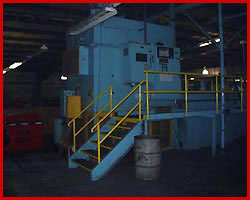 Heat Treating This is a heat treating oven that can help in a number of ways for the strengthening of the tubing. Click on Tennalum at the bottom of the page to learn more about different heat treatments.
Heat Treating This is a heat treating oven that can help in a number of ways for the strengthening of the tubing. Click on Tennalum at the bottom of the page to learn more about different heat treatments.
Glossary of Terms
AGING----A reaction of the alloying elements taking place in the heat-treatable alloys after solution heat-treatment that brings about an increase in hardness and strength with a decrease in ductility. The reason may occur at room temperature and is defined as natural aging. The speed of the reaction can be accelerated if it takes place at an elevated temperature in the250°F to 450°F range where it is defined as artificial aging.
ANNEALING----A thermal treatment used to soften the metal by removal of stresses from cold working or by coalescing precipitates from solid solution. When the mental is fully softened it is call a full anneal. When only some of the stresses are removed it is called a partial anneal. In the latter case, the metal is stronger but less ductile than in the case of a full anneal.
Swedging
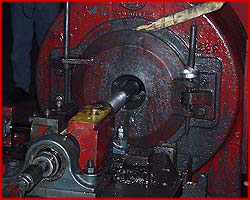 Here is a photo of the C-405 tubing being swedge. The swedging machine's costs around $125,000. And when you are working this machine you must have safety ear plugs in because of the loudness of the machine. To me this is oe tough job just because of the sound. The swedging is the part that actually forms the C-405 tubing into the shape of the softball bat. Here is a picture of the C-405 tubing right before it is placed in the swedger. Once the tubing has been swedge it will cool off and will actually be right around 40 inches long. It is then cut off at both ends tofit it with the correct sizes.
Here is a photo of the C-405 tubing being swedge. The swedging machine's costs around $125,000. And when you are working this machine you must have safety ear plugs in because of the loudness of the machine. To me this is oe tough job just because of the sound. The swedging is the part that actually forms the C-405 tubing into the shape of the softball bat. Here is a picture of the C-405 tubing right before it is placed in the swedger. Once the tubing has been swedge it will cool off and will actually be right around 40 inches long. It is then cut off at both ends tofit it with the correct sizes.
BAR----A solid section of metal that is long in relation to its cross section, which is square, rectangular or is a regular hexagon or octagon, and in which at least one perpendicular distance between parallel faces is 0.375 inches or greater.
COLD FINISHED----Rod or bar brought to a final diameter or thickness by means of a cross section reduction applies to the metal when it is at room temperature. Examples are cold rolling, cold drawing or cold extruding.
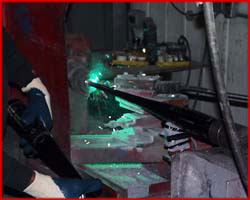 Welding One of the more heated jobs at producing a softball/baseball bat is the welding of the knob. Here the machinist is welding a knob on one of the different baseball bats.
Welding One of the more heated jobs at producing a softball/baseball bat is the welding of the knob. Here the machinist is welding a knob on one of the different baseball bats.
COLD WORKING-----Material reduction of deformation carried on at temperatures below those resulting in the recrystallization or annealing of the metal. Cold working of the metal will bring about strain-hardening with an increase in strength and hardness.
ELONGATION---- This property designates the ability of the metal to stretch, or elongate, when it is subjected to an applied stress. The distance the metal will stretch from the point where yielding begins to the point where the metal fractures is expressed as a percentage and is known as the elongation.
HEAT-TREATABLE ALLOYS----Alloys, typically in the 2XXX, 6XXX and 7XXX series, that achieve their maximum strength either through solution heat treating and cold work.
SOLUTION HEAT TREATING-----Normally used to describe a process where metal is heated at a high enough temperature to put soluble elements into solid solution
.
HOT WORKING----- Working the metal at such a high temperature that strain hardening does not occur.
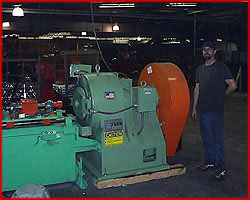 New Swedging Machine
New Swedging Machine
Cost - $120,000.00
NON-HEAT-TREATABLE ALLOYS-----The most definitive term for the 1XXX, the 3XXX, the 5XXX and some 4XXX alloy classes. These alloys gain strength through cold working and lose strength through thermal treatments.
NON-HEAT-TREATABLE ALLOYS-----The most definitive term for the 1XXX, the 3XXX, the 5XXX and some 4XXX alloy classes. These alloys gain strength through cold working and lose strength through thermal treatments.
QUENCHING---- A closely controlled rapid cooling of metal from some type of high temperature operation such as heat treating or extruding. The cooling medium is usually water and the purpose is to chill the metal quickly and lock the alloying elements into the dispersed positions imparted to them by the high temperature operation.
ROD---- A solid round section 0.375" or greater in diameter.
STRESS RELIEVING------Often confused with ferrous stress relieval treatments, this process mechanically stress relieves the aluminum by stretching the rod or bar thus achieving a permanent increase in length and low residual stress levels.
ULTIMATE TENSILE STRENGTH (UTS)-----A common term to describe mechanical strength. This metal property denotes how much stress can be gradually applied to the metal before it fractures. Tensile testing is done by pulling two ends of a test sample in opposite directions under a constantly increasing force, subjecting the product to stress. The stress is measured until the product is pulled in two. The measurement at the exact time of fracture is the material's ultimate tensile strength.
WIRE----- A definition of wire is just about the same as the definition for bar, in that wire can be almost any cross section, but, unlike bar, wire can be round. The major differences lies in the fact that the minor dimension for bar must be at least three-eighths of an inch (.375") while the major dimension for wire must be under three-eighths of an inch.
Aluminum Companies
Kaiser Aluminum
Pechiney Aluminum
Tennalum
Aluminum Alloys
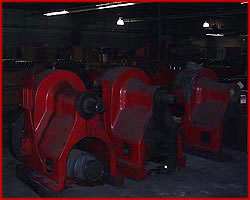 Extra Swedgers
Extra Swedgers
Since swedging is one of the most important parts of softball bat manufacturing Bat companies have a number of extra swedgers just in case one breaks down and you need a part real fast. All in all this company has 6 swedgers so they can do 20,000 bats a month.
WROUGHT PRODUCTS-----Products which can began as raw material castings and are mechanically worked by processes such as rolling, extruding and forging to the extent that all remnants of the cast metallurgical structure have been removed.
YIELD TENSILE STRENGTH (YTS)----- A property of the material that describes the stress at which the material exhibits a specific permanent set. That is the point at which it will not spring back to its original length when stress in the material is relieved. For aluminum the yield strength is usually measured at the point where the stress applied to the material causes a 0.2% permanent set.